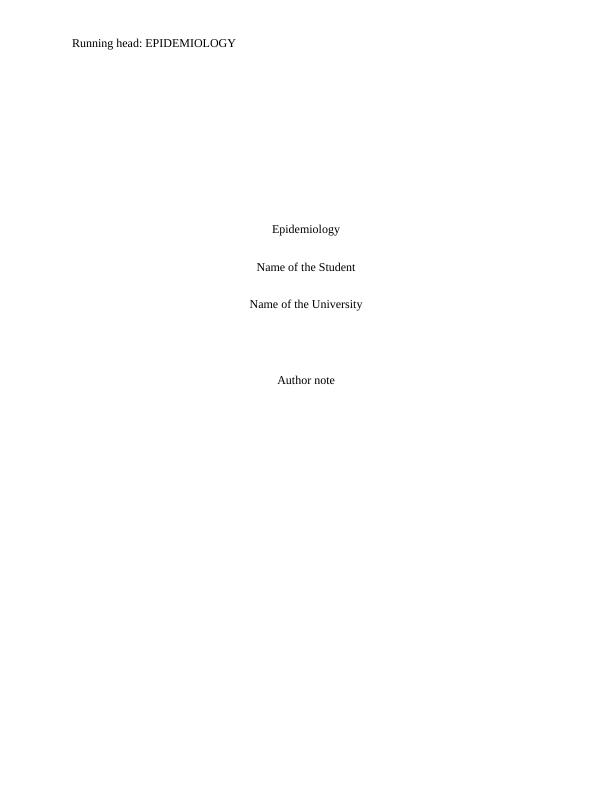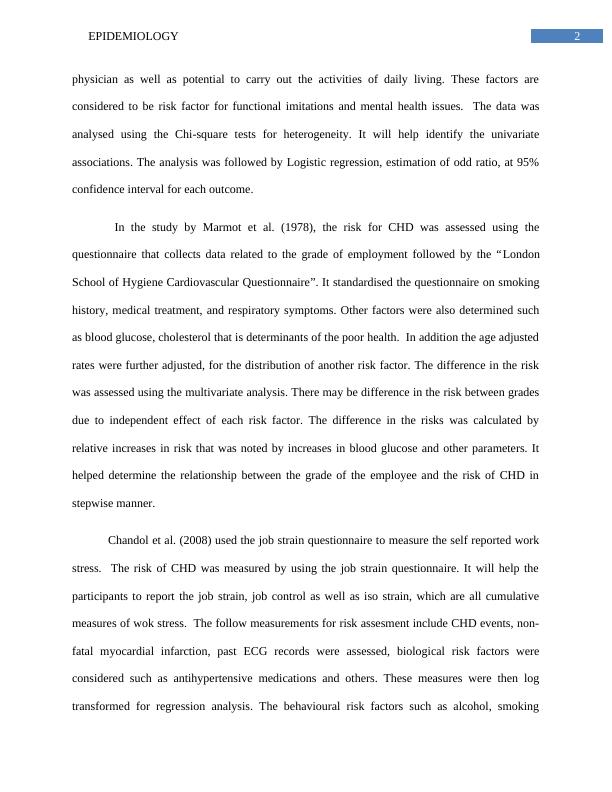Epidemiology: Risk Assessment, Generalisability, Feasibility and Limitations
Added on 2023-06-10
6 Pages1362 Words123 Views
Running head: EPIDEMIOLOGY
Epidemiology
Name of the Student
Name of the University
Author note
Epidemiology
Name of the Student
Name of the University
Author note

1EPIDEMIOLOGY
Sampling frame
In the Whitehall study I there was comparison of the mortality of all people of the British
civil servants in the highly stratified environment. It investigated the link between employment
grade and poor health outcomes or functional limitations. Around 19029 male civil servants were
examined aged of 40 and 69 over a period of 10 years. In the second Whitehall study, the health
of 400 civil servants (survivors) was investigated (aged 35 to 55). Among them two thirds were
men and one third women and the study was conducted from 1997 to 1988 (Breeze et al., 2001).
As per Chandol et al. (2008) there were 10308 civil servants from 20 departments in Whitehall
study II conducted in 1985–88 (phase 1). The phase II was carried out in the 1989–90, and phase
III was carried out in 1991–93, and the phase IV was conducted in 1995. The phase VI was
conducted in 2001. The phase 7 was conducted in 2002–04. By phase 7 6484 attended the
clinical examination. In this study the author examined the biological and behavioural factor
associated with work stress and coronary heart disease. As per Marmot et al. (1978), the initial
phase of the longitudinal study comprised of 17 530 civil servants for examining the relationship
between the coronary risk factors, employment, and coronary heart disease (CHD) mortality.
Risk assessment
In the study by Breeze et al. (2001), the risk of disease was assessed by comparing the
participants’ data in Whitehall study I with the study II. The data includes questionnaires
concerning the smoking habits, personal and family medical histories, and related to job,
physical activity, leisure activity and others. The researcher assed for the blood pressure,
cholesterol, height and weight as well analysed blood sugar. The resurvey questionnaires
collected data related to socioeconomic status (SES) and retirement, diseases diagnosed by
Sampling frame
In the Whitehall study I there was comparison of the mortality of all people of the British
civil servants in the highly stratified environment. It investigated the link between employment
grade and poor health outcomes or functional limitations. Around 19029 male civil servants were
examined aged of 40 and 69 over a period of 10 years. In the second Whitehall study, the health
of 400 civil servants (survivors) was investigated (aged 35 to 55). Among them two thirds were
men and one third women and the study was conducted from 1997 to 1988 (Breeze et al., 2001).
As per Chandol et al. (2008) there were 10308 civil servants from 20 departments in Whitehall
study II conducted in 1985–88 (phase 1). The phase II was carried out in the 1989–90, and phase
III was carried out in 1991–93, and the phase IV was conducted in 1995. The phase VI was
conducted in 2001. The phase 7 was conducted in 2002–04. By phase 7 6484 attended the
clinical examination. In this study the author examined the biological and behavioural factor
associated with work stress and coronary heart disease. As per Marmot et al. (1978), the initial
phase of the longitudinal study comprised of 17 530 civil servants for examining the relationship
between the coronary risk factors, employment, and coronary heart disease (CHD) mortality.
Risk assessment
In the study by Breeze et al. (2001), the risk of disease was assessed by comparing the
participants’ data in Whitehall study I with the study II. The data includes questionnaires
concerning the smoking habits, personal and family medical histories, and related to job,
physical activity, leisure activity and others. The researcher assed for the blood pressure,
cholesterol, height and weight as well analysed blood sugar. The resurvey questionnaires
collected data related to socioeconomic status (SES) and retirement, diseases diagnosed by

2EPIDEMIOLOGY
physician as well as potential to carry out the activities of daily living. These factors are
considered to be risk factor for functional imitations and mental health issues. The data was
analysed using the Chi-square tests for heterogeneity. It will help identify the univariate
associations. The analysis was followed by Logistic regression, estimation of odd ratio, at 95%
confidence interval for each outcome.
In the study by Marmot et al. (1978), the risk for CHD was assessed using the
questionnaire that collects data related to the grade of employment followed by the “London
School of Hygiene Cardiovascular Questionnaire”. It standardised the questionnaire on smoking
history, medical treatment, and respiratory symptoms. Other factors were also determined such
as blood glucose, cholesterol that is determinants of the poor health. In addition the age adjusted
rates were further adjusted, for the distribution of another risk factor. The difference in the risk
was assessed using the multivariate analysis. There may be difference in the risk between grades
due to independent effect of each risk factor. The difference in the risks was calculated by
relative increases in risk that was noted by increases in blood glucose and other parameters. It
helped determine the relationship between the grade of the employee and the risk of CHD in
stepwise manner.
Chandol et al. (2008) used the job strain questionnaire to measure the self reported work
stress. The risk of CHD was measured by using the job strain questionnaire. It will help the
participants to report the job strain, job control as well as iso strain, which are all cumulative
measures of wok stress. The follow measurements for risk assesment include CHD events, non-
fatal myocardial infarction, past ECG records were assessed, biological risk factors were
considered such as antihypertensive medications and others. These measures were then log
transformed for regression analysis. The behavioural risk factors such as alcohol, smoking
physician as well as potential to carry out the activities of daily living. These factors are
considered to be risk factor for functional imitations and mental health issues. The data was
analysed using the Chi-square tests for heterogeneity. It will help identify the univariate
associations. The analysis was followed by Logistic regression, estimation of odd ratio, at 95%
confidence interval for each outcome.
In the study by Marmot et al. (1978), the risk for CHD was assessed using the
questionnaire that collects data related to the grade of employment followed by the “London
School of Hygiene Cardiovascular Questionnaire”. It standardised the questionnaire on smoking
history, medical treatment, and respiratory symptoms. Other factors were also determined such
as blood glucose, cholesterol that is determinants of the poor health. In addition the age adjusted
rates were further adjusted, for the distribution of another risk factor. The difference in the risk
was assessed using the multivariate analysis. There may be difference in the risk between grades
due to independent effect of each risk factor. The difference in the risks was calculated by
relative increases in risk that was noted by increases in blood glucose and other parameters. It
helped determine the relationship between the grade of the employee and the risk of CHD in
stepwise manner.
Chandol et al. (2008) used the job strain questionnaire to measure the self reported work
stress. The risk of CHD was measured by using the job strain questionnaire. It will help the
participants to report the job strain, job control as well as iso strain, which are all cumulative
measures of wok stress. The follow measurements for risk assesment include CHD events, non-
fatal myocardial infarction, past ECG records were assessed, biological risk factors were
considered such as antihypertensive medications and others. These measures were then log
transformed for regression analysis. The behavioural risk factors such as alcohol, smoking

End of preview
Want to access all the pages? Upload your documents or become a member.
Related Documents
Healthcare Epidemiology Answer 2022lg...
|9
|1906
|10
Study Design and Sampling in Whitehall Studieslg...
|11
|2892
|247
Study Design, Sampling and Population Risk in Epidemiologylg...
|7
|1920
|141
Study Design, Sampling and Population Risklg...
|11
|2842
|226
Impact of Socio-economic Status on Cardiovascular Disease: A Comparative Studylg...
|8
|2017
|368
Study Design for Research: Types, Advantages and Disadvantageslg...
|9
|2387
|397